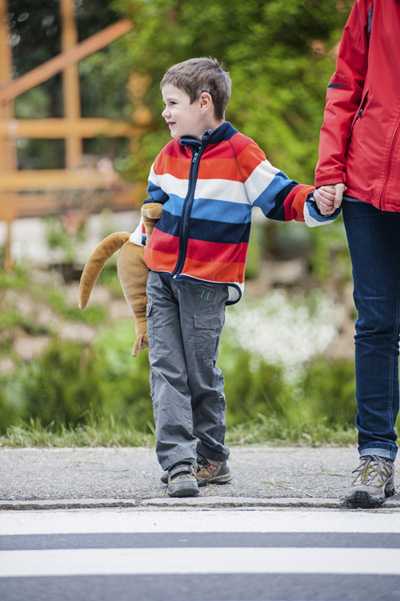Wandering (Elopement)

Wandering, also called elopement, is an important safety issue that affects some people with disabilities, their families, and the community. There are steps that parents, teachers, healthcare providers, and others can take to help keep children safe.
Wandering is when someone leaves a safe area or a responsible caregiver. This typically includes situations where the person may be injured or harmed as a result.1 Wandering goes beyond the brief time that a typical toddler might run off from a caregiver. Some children and youth with disabilities, such as those with autism spectrum disorder (ASD) or intellectual disability (ID), have challenges understanding safety issues and communicating with others. For example, such a child might run off from home to play in the pond down the street- and be unable to respond to his name or say where he lives. This can happen quickly, even under constant supervision. The child’s parents are left searching desperately for him or her.
Based on a survey of parents, about half of children and youth with ASD were reported to wander. Of those children, 1 in 4 were missing long enough to cause concern and were most commonly in danger of drowning or traffic injury. Children wandered most often from their own home or another home, stores, and classrooms or schools. The primary reasons for wandering included:
- Enjoyment of running or exploring
- To get to a place he or she enjoys (like a pond)
- To get out of a situation that causes stress (for example, being asked to do something at school or getting away from a loud noise)
- To go see something interesting (for example, running to the road to see a road sign)
Although many examples of dangerous wandering have focused on children with ASD, we know that challenges with communication, social interaction, attention, and learning can put many children and youth with developmental disabilities at risk for becoming lost or injured due to wandering.
What Can We Do to Keep Children Safe Who Might Wander?
Parents, Teachers, and Other Caregivers
Plan
- Watch the child’s behaviors
- Have an emergency plan to respond
- Keep information about the child up-to-date (picture, description)
- Secure your home (fences, door locks)
- Keep identification on the child (ID bracelet or information card)
Prevent
- Notice signs that the child may wander off before it happens (for example, child makes a certain sound or looks towards the door)
- Be alert about the child’s location
- Provide a safe location
- Inform neighbors and school workers
- Alert first responders
Teach Safety Skills
- Responding to safety commands (“stop”)
- Stating name and phone number (or showing ID)
- Swimming, crossing the street
First Responders
First responders are vital for maintaining the health and safety of members of our communities. They are likely to be called upon in the event of a missing child or youth. It is important for first responders to be prepared by knowing which children in the community might wander, having family contact information, and having a plan to respond. Tools and training materials are available through the AWAARE organization and through the National Center for Missing and Exploited Children.
Healthcare Providers and Other Professionals
Healthcare and other professionals need to be aware of wandering as a safety issue. Their role includes discussing safety issues and helping caregivers come up with prevention and response plans. Tools and information to help are listed in the “Resources” section below.
The ICD-10-CM code Z91.83 (wandering in diseases classified elsewhere) helps document wandering and to prompt important discussions about safety among caregivers, individuals, and providers. This code is not linked to a specific diagnosis, nor is it part of the diagnostic codes used for ASD or intellectual disabilities. Wandering should be coded if documented in the medical record by the provider (i.e., physician).
CDC’s Work
CDC works to keep people safe and healthy and this includes addressing the special needs that people with disabilities may have. CDC has partnered with others to understand how common wandering or elopement is among children with ASD and other developmental disabilities. CDC has served on the Interagency Autism Coordinating Committee (IACC) Safety Subcommittee, assisted in data collection on wandering, and worked with partners to raise awareness of wandering as an important safety issue.
Resources
The AAP provides information and resources for professionals and families on the identification and healthcare management of children and youth with an autism spectrum disorder (ASD).
AWAARE.org
This site has information and resources to prevent and respond to potentially dangerous wandering. This includes The Big Red Safety Toolkit for caregivers and first responders related to wandering.
iancommunity.org
The Interactive Autism (IAN) Network has surveyed caregivers about the occurrence of wandering among children with ASD and their siblings.
Autism Speaks’ Safety Project
This site includes information and tips on safety for people with ASD and their families.
Autism Society
The Autism Society of America has been improving the lives of all affected by autism for over 50 years and envisions a world where individuals and families living with autism are able to maximize their quality of life, are treated with the highest level of dignity, and live in a society in which their talents and skills are appreciated and valued.
The National Center for Missing and Exploited Children
This organization has put together tools and guides for first responder and search terms to help in training and response to missing children with special needs.
References
- Anderson C, Law JK, Daniels A, Rice C, Mandell DS, Hagopian L, Law PA. Occurrence and family impact of elopement in children with autism spectrum disorders. Pediatrics. 2012 Nov;130(5):870-7. doi: 10.1542/peds.2012-0762. Epub 2012 Oct 8.
- Page last reviewed: July 31, 2017
- Page last updated: July 31, 2017
- Content source:




 ShareCompartir
ShareCompartir